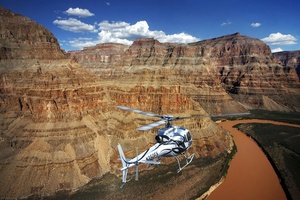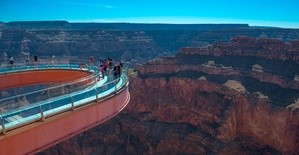Where is it located?
2The Grand Canyon is located in the state of Arizona in the southwestern United States. At the far north of the Grand Canyon is Lake Powell and the city of Page, on the Utah-Arizona border. Lake Mead is located on the Arizona-Nevada border at the canyon's western end, where the Colorado River empties.
5The Grand Canyon, which is on the UNESCO World Heritage List, contains various regions. The Grand Canyon National Park is the most famous of these and attracts the most tourists. 3The national park has two main zones: the North Rim and the more accessible Southern Rim. All parts of the canyon are open to visitors and suitable for walking. However, the National Park and Southern Edge area is the best equipped, hosting millions of visitors throughout the year.
History
4Native Americans have inhabited the Grand Canyon for thousands of years in its caves, and it is also considered sacred by the Pueblo people. The first European to see the Grand Canyon was Garcia López de Cárdenas, who came to the region in 1540. The ancestors of the Pueblos were the first people to live in the Grand Canyon area. In 1540, the Spaniards discovered the southern rim of the canyon. In 1858, the American John Strong Newberry was the first geologist to come to the region. The Grand Canyon was granted National Monument status in 1908 and National Park status in 1919.
Pre-European History
4Archaeologists have discovered archaeological remains and artifacts from residents of the Grand Canyon who lived about 12,000 years ago. Prehistoric humans first settled in and around the canyon during the last Ice Age, when mammoths, giant animals, and other large mammals inhabited North America. Large stone spear points found by archaeologists provide important evidence for early human settlement. Hundreds of small twig beetle figures made between 2000 and 1000 BC were discovered in caves on the canyon wall. Anthropologists think that prehistoric hunters drew these figures on the walls of caves to ensure a successful hunt. The Pueblo people once inhabited the Grand Canyon, followed by the Paiute, Navajo, Zuni, and Hopi tribes. The Havasupai people now consider the Grand Canyon their ancestral home and have lived in and around the canyon for over 800 years.
Nature of the Grand canyon
1Various habitats have been formed in the Grand Canyon due to the climatic changes due to the altitude differences. Some of these areas have been named Lower Sonoran, Upper Sonoran, Transitional, Canadian, and Hudsonian. Plant species vary by region, and an enormous variety of creatures live in the canyon. There are hundreds of plant species in the Grand Canyon. The reason for this diversity is the elevation of up to 2,400 meters in the canyon, located on the Northern Edge of the Colorado River. Sixty-three species in the Grand Canyon, which also has endemic (grown only in that region) plants, have been given special status by the US Fish and Wildlife Service. On the other hand, 90 mammal species, including rodents and bats, live in the Colorado River corridor. Many other animals, such as reptiles, birds, and butterflies, are other natives living in the Grand Canyon.
Things To Do in the Grand Canyon
3The Grand Canyon has hiking opportunities with a variety of routes. The scenery of this hike, which is one of the unique experiences in the world, is breathtaking. In addition to opportunities to meet adventurers' expectations, guided tours are also organized. It is also possible to follow challenging routes due to elevation changes and a easier path to walk and offers excellent views. Hikers should take the warnings very seriously. During the walk, the changing temperatures during the day should be taken into account. Whitewater Rafting is another popular activity, and trips are organized on the river between 3 and 18 days. On the other hand, Flightseeing is an impressive activity that offers a wide-angle cruise to the canyon with airplane and helicopter tours.
Sources:
1Canyon history. Nature Culture and History at the Grand Canyon. (n.d.). Retrieved April 9, 2022, from https://grcahistory.org/history/
2History.com Editors. (2009, December 2). Grand canyon. History.com. Retrieved April 9, 2022, from https://www.history.com/topics/landmarks/grand-canyon
3First-timer's guide to the grand canyon. Visit Arizona. (n.d.). Retrieved April 9, 2022, from https://www.visitarizona.com/like-a-local/first-timer-s-guide-to-the-grand-canyon/
4The Grand Canyon throughout time. Grand Canyon National Park Trips. (2021, March 9). Retrieved April 9, 2022, from https://www.mygrandcanyonpark.com/park/history/history-of-the-grand-canyon/
5UNESCO Multimedia Archives. (n.d.). Retrieved April 9, 2022, from https://www.unesco.org/archives/multimedia/search/grand+canyon
6U.S. Department of the Interior. (n.d.). Interpretive themes for artist and author. National Parks Service. Retrieved April 9, 2022, from https://www.nps.gov/grca/learn/historyculture/interp_themes.htm




